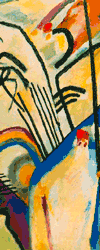
Visual Culture
|
 |
Visual Culture |
|||||||||||
|
Art 208 Italian Renaissance Art and Culture |
| • U of Idaho | • College of Art and Architecture | • Department of Art & Design |
 |
Though rooted in a tradition that can be traced back to the Italian Renaissance and, beyond that, to classical antiquity, the history of art, that is to say, the historical analysis and interpretation of man-made objects to which we assign a more than utilitarian value, has recently evolved to embrace the larger field of visual culture in general. Art and visual culture have always existed, but it is in our modern and postmodern world that images and visualization in general have become arguably the most potent forces in the formation, development, and dissemination of information and knowledge. With this in mind, the Department of Art and Design's courses in Art History, Theory, and Visual Culture offer a rigorous grounding in the history, theory, and cultural revelancy of images and their environments. Vision, visualization, in short, the visual, is quite simply the most
vital location for the production of meaning, knowledge and information
in our world today. What has been called “the visual turn”--the
proliferation and dissemination of images and the visual, more or less
beginning with the invention of photography in the 19th century—has
been recognized as one of the most important fields of inquiry for not
only the humanities but for all the cross-disciplinary components of cultural
studies in general. As a subject that touches upon the most potent components
of globalization and cultural exchange in today’s societies it is
of infinite relevancy for every student in the university, and something
that will only continue to grow in importance in the 21st century. What
is important to emphasize is that our courses underscore the role of
images and the visual from the perspective of various disciplines and
theoretical and cultural perspectives. The study and critique of the visual
as a cultural product is something of deep concern for philosophy, literature,
linguistic studies, the social sciences, medicine, economics, architecture,
communications, and of course the humanities in general. Our courses provide a rigorous grounding in the history, theory, and cultural
relevancy of images and their environments. Through a consistent emphasis
on an interdisciplinary and comparative approach, our Art History, Theory, and Visual Culture courses focus
on the inherent historical and cultural intersections between the fine
and applied arts, design, architecture, music, dance, theater, history,
literature, philosophy, the social sciences, and foreign languages. Each
course in the curriculum facilitates communication between disciplines
and encourages an understanding of the complex interrelations between
the conception, design, creation, construction, and dissemination of cultural
products, an issue of great relevancy in today’s highly visualized
world. Our courses provide not just the Department of Art and Design
and the College of Art and Architecture, but the University
of Idaho at large, with a model interdisciplinary approach that extends
beyond the conservative academic boundaries of traditional Art History
courses.
|
|
||
|
|